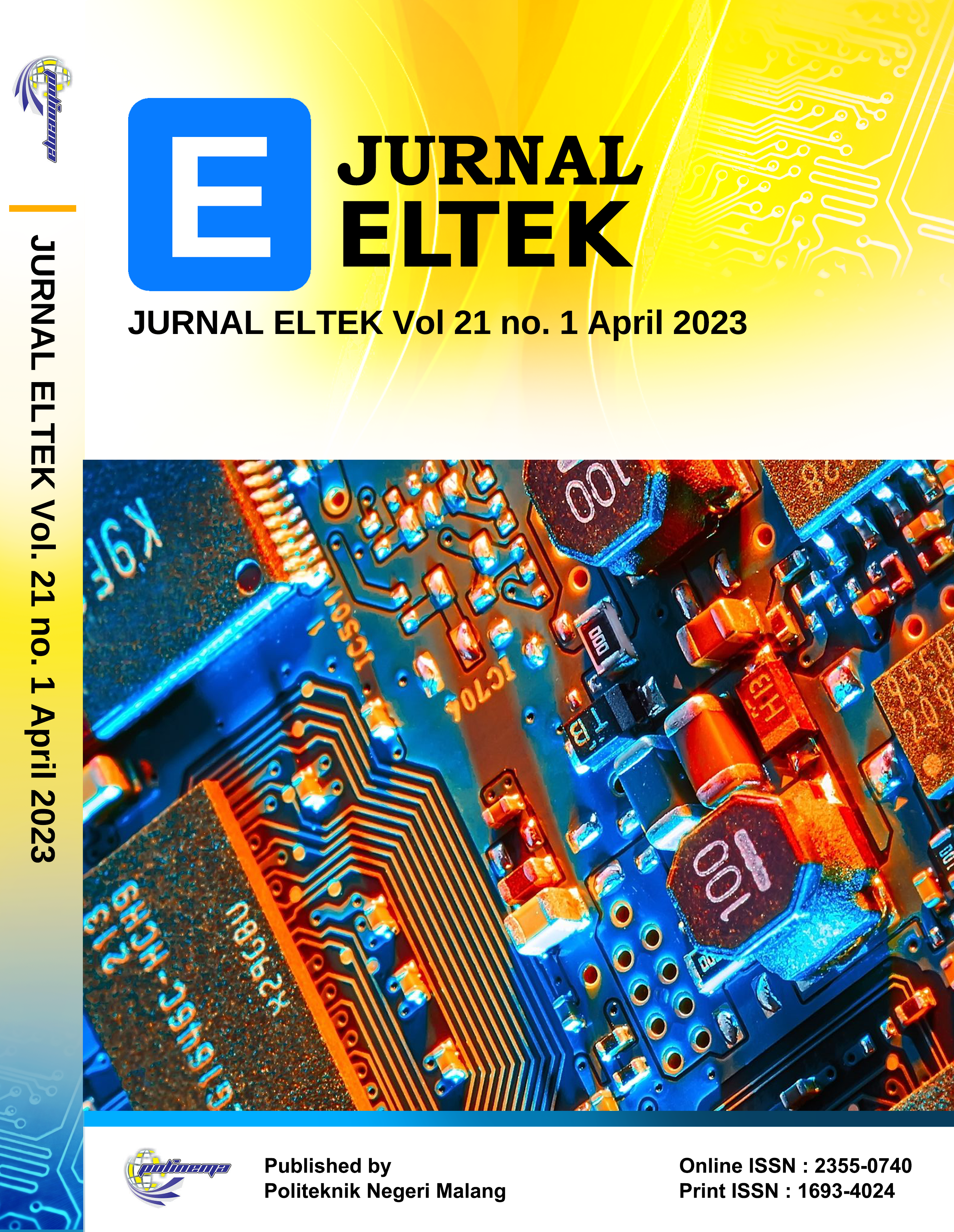Desain kontrol adaptif L1 dengan band pass filter orde dua untuk pengendali vibrasi pada rotor helikopter
DOI:
https://doi.org/10.33795/eltek.v21i1.380Keywords:
Band Pass Filter, Kontrol Adaptif L1, Vibrasi HelikopterAbstract
Vibrasi pada helikopter menjadi konsentrasi tersendiri untuk terus ditingkatkan penanganannya. Hal ini dikarenakan selain dapat menyebabkan kerusakan struktur badan helikopter jika vibrasi yang dihasilkan terlalu besar juga berpengaruh pada kenyamanan pilot dan penumpang. Sistem vibrasi pada helicopter terdiri dari baling-baling, rotor mount, dan suspensi dimana terdapat damper sebagai peredam. Pada penelitian ini, digunakan damper semi aktif yang variabelnya dikontrol dengan menggunakan kontrol adaptif L1 berbasis analisis Fourier dari vibrasi yang dihasilkan oleh rotor. Analisis Fourier digunakan untuk mencari frekuensi cutoff vibrasi yang digunakan untuk penalaan pada kontrol adaptif L1. Hasil rancangan band pass filter orde 2 pada sistem dapat memperbaiki respon percepatan hingga 72.52% pada rotor mount dan 65.94% badan helicopter dalam waktu 2 detik. Hasil rancangan juga dapat menangani kesalahan perpindahan sebesar 55.6% pada rotor mount dan 55.56% pada badan helikopter dalam waktu 2 detik. Perbaikan respon percepatan pada badan helicopter yang mencapai 0 m/s2 telah memenuhi rekomendasi NASA untuk minimal percepatan pada sistem vibrasi helikopter.
ABSTRACT
Vibration in helicopters is a separate concentration to continue to improve its handling. This is because, in addition to causing damage to the helicopter body structure if the vibration generated are too large, it also affects the comfort of pilot and passengers. The vibration system on the helicopter consists of propeller, rotor mount, and suspension where there are dampers as dampers. In this research, a semi-active damper is used whose variables are controlled using Fourier analysis-based L1 adaptive control of the vibrations generated by the rotor. Fourier analysis is used to find the cutoff frequency of vibration used for tuning the L1 adaptive control. The results of the second-order band pass filter design in the system can improve the acceleration response up to 72.52% on the rotor mount and 65.94% of the helicopter body within 2 seconds. The design results can also handle displacement errors of 55.6% on the rotor mount and 55.56% on the helicopter body within 2 seconds. The improvement of the acceleration response on the helicopter body which reaches 0 m/s2 has required NASA's recommendations for minimum acceleration in helicopter vibration systems.
References
K. Zhou dan J. C. Doyle, Essentials of Robust Control, Prentice Hall, 1999.
C. W. d. Silva, Vibration: Fundamental and Practice, London: CRC Press, 2000.
N. Hovakimyan dan C. Cao, L 1 Adaptive Control Theory: Guaranteed Robustness with Fast Adaptation Advanced in Design and Control , Siam, 2010.
N. Hovakimyan, C. Cao, E. Kharisov, E. Xargay dan I. M. Gregory, L_1 Adaptive Control for Safety-Critical Systems, IEEE Control Systems Magazine, October 2011.
M P Norton dan D G Karczub, Fundamentals of noise and vibration analysis for engineers, Physical Communication, Cambridge: Cambride University Press, 2003.
F. Gamar, R. E. Abdul Kadir, dan A. Jazidie, "Application of L_1 Adaptive Control for Helicopter Vibration," pada 10th International Conference on Information Technology and Electrical Engineering (ICITEE), Bali, Indonesia, July 24-26, 2018.
R. N. Sandage, P. M. Patil and S. A. Patil, “Simulation Analysis of 2dof Quarter Car Semi-Active Suspension System to Improve Ride Comfort - A Review,” International Journal of Application or Innovation in Engineering & Management (IJAIEM), vol. 2, no. 12, pp. 339-345, 2013.
H. D. Du and M. Lovera, “Robust Harmonic Control an Application to Structural Vibration Reduction in Helicopter,” Milan, 2013.
B. Titurus, “Vibration Control in a Helicopter with Semi-Active Hydraulic Lag Dampers,” Journal of Guidance, Control, and Dynamics, vol. 36, no. 2, 2013.
Y. Uppatthangkul and H. Ohmori, “Optimizing Vehicle MR Damper Semi-Active Suspension Control System by L1 Adaptive Control with Linear Time Invariant Controller,” 2015.
A. Pettersson, K. J. Astrom, A. Roberttsson and R. Johansson, “Analysis of Linear L1 Adaptive Control Architectures for Aerospace Application,” in 51st IEEE Conference on Decision and Control, Maui, 2012.
C. Kessler, “Active Rotor Control for Helicopters: Motivation and Survey on Higher Harmonic Control,” CEAS Aeronaut J, vol. 1, pp. 3-22, 2011.
Bilji C. M., Prasun Banerjee, dkk., “ A Review on Vibration Analysis of Helicopter Rotor Blade”, International Journal for research in Applied Science & Engineering Technology (IJRASET), vol. 10, 2022.
Koulocheris, D., Papaioannou, G., dan Chrysos, E., “A Comparison of Optimal Semi-active Suspension Systems Regarding Vehicle Ride Comfort”, CAR2017 International Congress of Automotive and Transport Engineering – Mobility, Pitesti, Romania, November 8-10, 2017.
A. Colina, G. Lerma, I. Cabanes, dan I. Iglesias, “Modelling and Control of a Semi-active Suspension System”, Proceedings of the Second Conference MeTrApp 2013, pp 25-32, 2013.
P. P. Friedmann and T. A. Millott, “Vibration Reduction in Rotorcraft Using Active Control: A Comparison of Various Approaches,” Journal of Guidance, Control, and Dynamics, vol. 18, no. 4, 1995.
Downloads
Published
How to Cite
Issue
Section
License
Copyright (c) 2023 Farida Gamar, Rusdhianto Effendie Abdul Kadir, Achmad Jazidie

This work is licensed under a Creative Commons Attribution-ShareAlike 4.0 International License.







